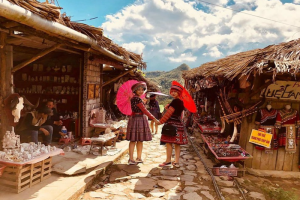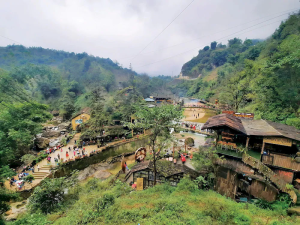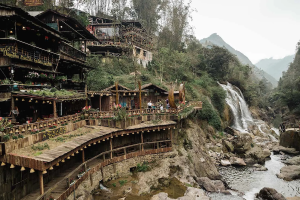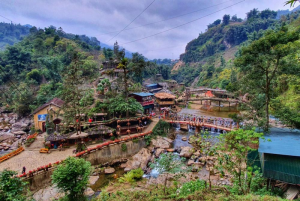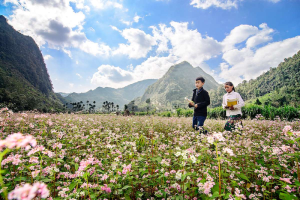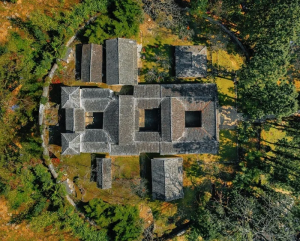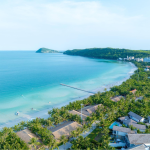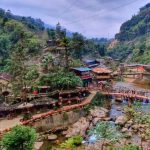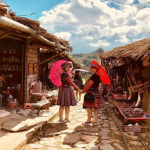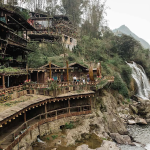Nestled in the rugged terrains of northeastern Vietnam, the Nho Que River captivates travelers with its breathtaking landscapes and rich cultural heritage. Flowing through Ha Giang and Cao Bang provinces, this picturesque river offers a unique and unforgettable experience. Whether you’re seeking adventure, tranquility, or a glimpse into local ethnic life, Lily’s Travel is here to guide you through all the essential information for planning your visit.
Where is Nho Que river?
The Nho Que River is located in northeastern Vietnam. It flows through the Ha Giang and Cao Bang provinces, which are known for their rugged and mountainous terrains. The river is particularly famous for its breathtaking views, especially in the Ma Pi Leng Pass area, where it creates a stunning deep gorge between steep cliffs. This location is a popular spot for tourists seeking dramatic natural scenery and is often highlighted in travel itineraries exploring the northern part of Vietnam.
The river stretches over 46 kilometers within Vietnam before it joins the Gam River. Its route through the deep valleys and steep mountains contributes to its dramatic and picturesque scenery, making it a prominent feature in the landscapes of the northern regions of Vietnam.
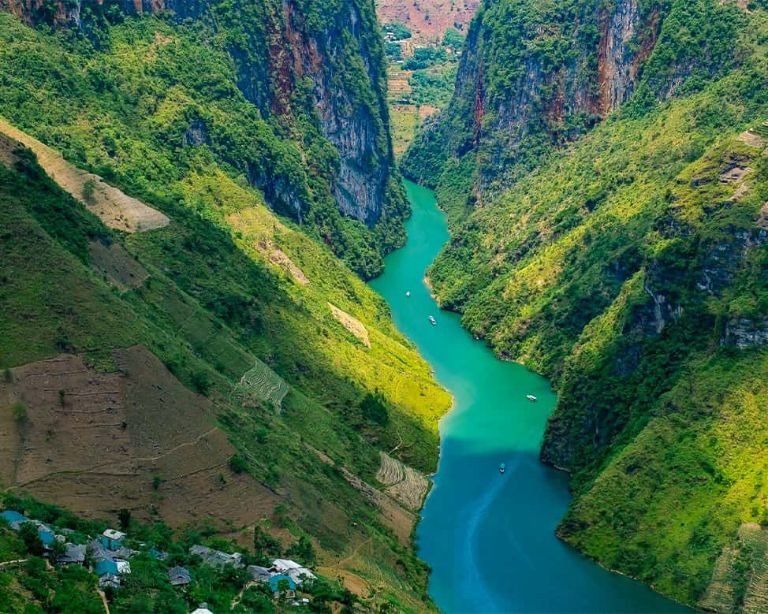
One of the most famous views of the Nho Que River is from the Ma Pi Leng Pass, which is part of the Dong Van Karst Plateau Global Geopark. The river runs at the bottom of one of the deepest gorges in Vietnam and can be viewed from high above on twisting mountain roads, providing stunning photographic opportunities.
Additionally, the river has cultural significance for the local ethnic communities, such as the H’Mong, Tay, and Nung, who live along its banks. These communities rely on the river for irrigation and fishing. The Nho Que River is also becoming increasingly popular for river-based tourism activities like boating, which offer unique perspectives of the majestic landscapes and a closer look at the rural life of the ethnic minorities in this remote part of Vietnam.
How to get to Nho Que river?
From Hanoi to Ha Giang City
Traveling by private car or personal motorcycle
The distance from Hanoi to Ha Giang is nearly 300km, with many steep slopes and tight turns along the way. The travel time between these two locations is about 5 – 6 hours, requiring drivers to have good driving skills.
Traveling by bus
Tourists wanting to visit Ha Giang City can opt for buses as their mode of transport. Buses from Hanoi to Ha Giang depart from My Dinh bus station. There are several bus companies serving this route with various departure times, making it easy for travelers to choose. To save time, tourists should consider taking an overnight bus to arrive in Ha Giang City early in the morning and start their sightseeing journey right away.
Traveling by airplane
For tourists from distant provinces such as the Central or Southern regions, if you wish to visit Ha Giang City, you must first take a flight to Hanoi City, after which you can continue your journey to Ha Giang by motorcycle, car, or bus.
Traveling to the Nho Que River docks
For those visiting Nho Que River for the first time, taking a boat is an exciting experience that allows you to fully appreciate the beauty of this scenic area. There are two Nho Que River docks to choose from: Ta Lang and Xin Cai. If departing from Dong Van town, it is convenient to choose Ta Lang dock. Conversely, if your itinerary extends to the top of Ma Pi Leng Pass, then head for Xin Cai dock.

Ta Lang Dock
From Dong Van, to get to Ta Lang Dock, you must head towards Ma Pi Leng Pass until you reach the area of Pai Lung commune, Meo Vac district. From there, you will see signs directing you to the yacht dock. This road has many steep slopes and dangerous curves, so you should check your vehicle before starting. If traveling by car, you must park at the start of the dock road, near Trang Huong bridge, and then hire someone to take you down.
Xin Cai Dock
Xin Cai commune is located in Meo Vac district, with the road into the commune running along the Nho Que River. At the end of Ma Pi Leng road, you will see signs directing you down to Nho Que River at Xin Cai port. The distance from the sign to the boat dock is about 5 km. Upon arrival, you must continue on foot for another 2 km to reach the boat docking point.
Activities and experiences at Nho Que river
Visitors to the Nho Que River will have the opportunity to experience the wonderful features described below.
Admiring the Ethereal Beauty of the Nho Que River
The Nho Que River boasts a poetic beauty, with its crystal-clear waters merging with the greenery of the mountains and vegetation in the Tu San Gorge. From the top of Ma Pi Leng Pass, visitors are awestruck by the endlessly winding, lush river. However, to fully appreciate the beauty of this scenic spot, you must choose a boat tour.
Boats depart from the Nho Que River dock, slowly moving downstream, allowing visitors to explore the landscapes of Ha Giang. The sheer cliffs, clear skies, and sounds of nature promise to leave you with unforgettable memories.
Escaping the Noisy, Dusty City to Enjoy the Fresh, Quiet Air
If you are tired of the noisy, dusty city, the Nho Que River is the ideal stop for you. Here, you can immerse yourself in a space filled with trees and flowers, listening to the birds singing and the water rippling along the banks. All these elements blend together to create a symphony of the mountains and forests that enchants everyone.
Visiting Tu San Gorge – “The Most Majestic”
From the Nho Que River dock, visitors will take a boat to the “supremely majestic” Tu San Gorge – a pride of Ha Giang tourism. The gorge is flanked by giant cat ear-shaped rock walls with unique geological structures, beneath which flows the clear waters of the Nho Que River, majestic yet dreamy. In this overwhelming space, people feel like they are lost in nature, becoming smaller than ever.
Kayaking Experience on the Nho Que River
The kayak service has only recently started but has quickly attracted young people to participate in the experience. Sitting in a kayak flowing with the current, visitors can observe the Nho Que River and Tu San Gorge from the closest distance. Not only merging with nature, but this activity also provides unique “Instagram-worthy” photo opportunities.
Price of Boat Service to Visit Nho Que River
Currently, tourists have three options for boats to visit the Nho Que River, each type of boat having a different price.

Motor Boats
Motor boats are equipped with seats, making them suitable for tourists in groups. They provide a comfortable way to save energy while enjoying the scenic views. Additionally, these boats allow for combining passengers, which helps to reduce costs, thus making them more affordable than other types of boats. The price for a motor boat ticket ranges from 100,000 to 150,000 VND per person, and the cost for renting the entire boat is even more favorable.
Self-Rowing Boats
Self-rowing boats are available in two types: wooden and iron, and are suitable for smaller groups. The cost for a trip on the Nho Que River in a self-rowing boat ranges from 100,000 to 150,000 VND per person. If you do not have experience in rowing, you can hire additional rowers.
Kayaks
Kayaking on the Nho Que River is an engaging experience, particularly popular among younger tourists. Kayaks are lightweight and easy to maneuver, with rental prices starting at just 50,000 VND per person.
FAQs
What is the best time of year to visit the Nho Que River?
The best time to visit the Nho Que River is from September to November or from March to May. During these months, the weather is pleasant, and the river is at its most scenic, with clear skies and lush green surroundings.
How can I get to the Nho Que River from Hanoi?
You can get to the Nho Que River from Hanoi by taking a bus, car, or motorcycle. The journey is approximately 300 km and takes about 6-8 hours. Buses to Ha Giang City depart from My Dinh bus station, and from Ha Giang, you can arrange for local transport to the river.
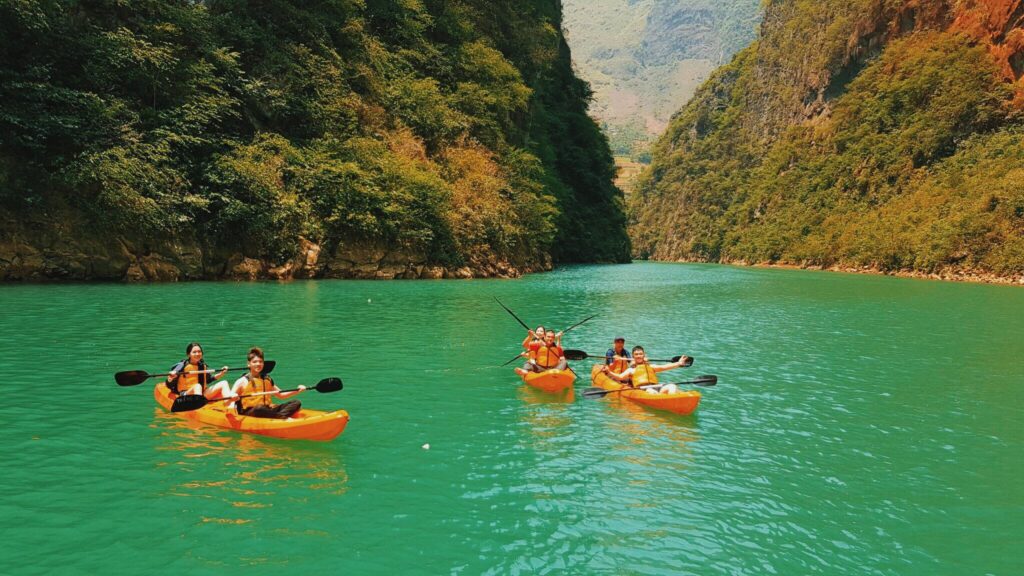
Are there any guided tours available to explore the Nho Que River and its surroundings?
Yes, there are several guided tours available that offer boat trips on the Nho Que River, as well as trekking tours around the Ma Pi Leng Pass and visits to local ethnic villages. These tours can be booked through local travel agencies or online.
Can you recommend any local dishes or restaurants near the Nho Que River area?
In the Ha Giang region, you can try local specialties such as “Thang Co” (a traditional Hmong soup), “Banh Cuon” (steamed rice rolls), and various grilled meats. Many local restaurants and homestays offer these dishes, particularly in Dong Van and Meo Vac towns.
Read more: Ma Pi Leng Pass – Legend of cloudy roads
What are the safety measures for boating or kayaking on the Nho Que River?
Safety measures include wearing life jackets, following the guide’s instructions, and ensuring the boat or kayak is in good condition. It’s also important to be aware of the weather conditions and avoid boating during heavy rains or strong winds.
Are there any particular cultural or historical sites to visit along the Nho Que River?
Yes, you can visit the Dong Van Karst Plateau, which is a UNESCO Global Geopark, the Hmong King’s Palace, and various traditional ethnic villages in the area. Each of these sites offers a glimpse into the rich cultural heritage of the region.
What kind of wildlife can I expect to see around the Nho Que River area?
The area around the Nho Que River is home to diverse wildlife, including various species of birds, butterflies, and small mammals. The lush vegetation also supports a variety of plant species, making it a great destination for nature lovers.
Can tourists participate in any traditional festivals or events in the Nho Que River region?
Yes, tourists can participate in local festivals such as the Khau Vai Love Market, which is held annually in May. This festival is a unique cultural event where ethnic minorities gather to celebrate, trade goods, and enjoy traditional music and dance.
What are the accommodation options near the Nho Que River? Are there homestays or hotels available?
There are several accommodation options near the Nho Que River, including homestays, guesthouses, and hotels. Popular areas for accommodation include Dong Van and Meo Vac towns, where you can find a range of options from basic homestays to more comfortable hotels. Homestays offer a chance to experience local culture and hospitality.
The Nho Que River is more than just a scenic spot; it’s a gateway to the natural and cultural wonders of northern Vietnam. From the awe-inspiring views of Ma Pi Leng Pass to serene boat trips, every moment promises lasting memories. With Lily’s Travel, discover the enchanting charm of this remarkable destination and ensure a trip that respects and appreciates its natural beauty and cultural significance. Plan your visit today with Lily’s Travel for an enriching experience.
Readmore: Lung Cu Flag Point – the rich cultural heritage of Ha Giang Vietnam





